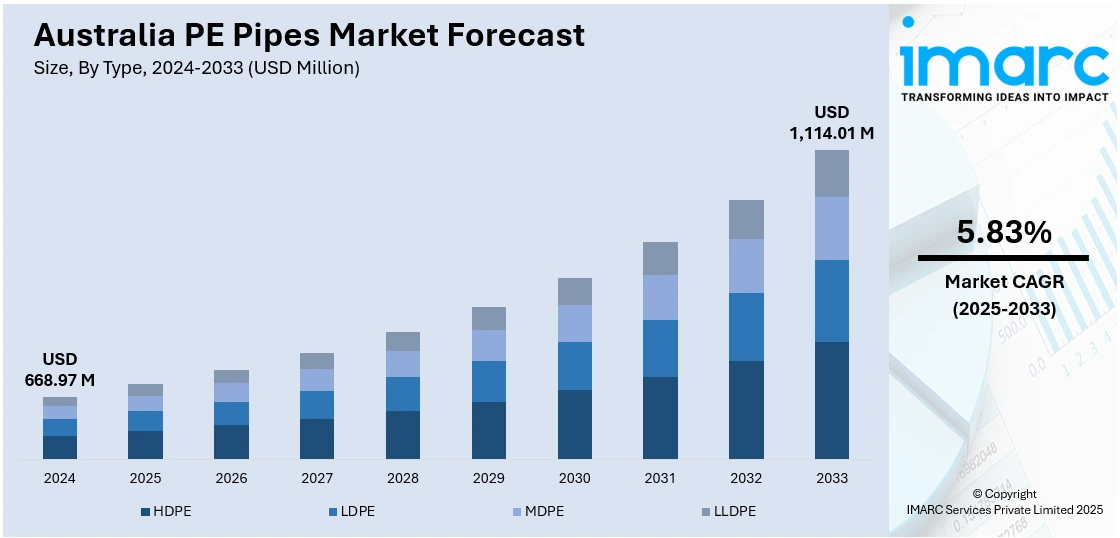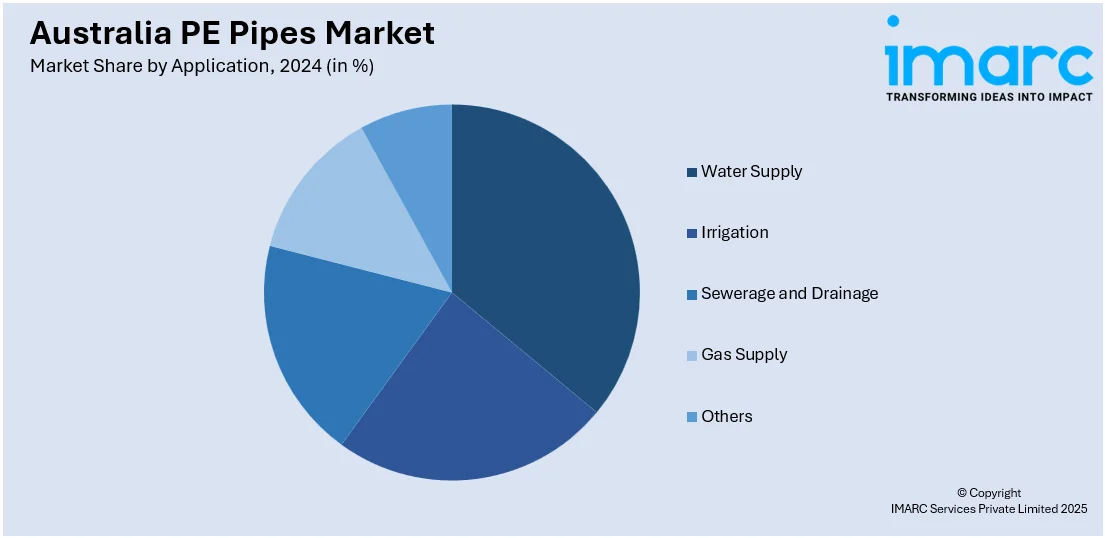
Australia PE Pipes Market Size, Share, Trends and Forecast by Type, Application, and Region, 2025-2033
Australia PE Pipes Market Overview:
The Australia PE pipes market size reached USD 668.97 Million in 2024. Looking forward, IMARC Group expects the market to reach USD 1,114.01 Million by 2033, exhibiting a growth rate (CAGR) of 5.83% during 2025-2033. The polyethylene PE pipes market in Australia is growing attributed to rising infrastructure projects demanding reliable piping for utilities and the increasing need in the mining sector for durable, corrosion-resistant systems that can withstand harsh environments and high-pressure operations with minimal maintenance across remote and technically demanding locations.
|
Report Attribute
|
Key Statistics
|
|---|---|
|
Base Year
|
2024
|
|
Forecast Years
|
2025-2033
|
|
Historical Years
|
2019-2024
|
| Market Size in 2024 | USD 668.97 Million |
| Market Forecast in 2033 | USD 1,114.01 Million |
| Market Growth Rate 2025-2033 | 5.83% |
Australia PE Pipes Market Trends:
Increasing Infrastructure Development
The accelerated pace of infrastructure development, especially in urbanizing regions, is bolstering the market growth. As new suburbs and regional hubs are expanding, the need for dependable, durable piping systems for crucial services like water distribution, sewage, and stormwater management keeps increasing. PE pipes are emerging as a popular option because of their flexibility, resistance to corrosion, and relatively straightforward installation method, which makes them suitable for various construction settings. The continual rise in residential, commercial, and industrial construction activities is catalyzing the demand for these piping solutions. For example, in 2025, the NSW government and Shoalhaven City Council announced two housing projects in Nowra. This encompasses the riverfront area, anticipated to provide as many as 270 residences, along with the Mandalay area, which is expected to contribute an additional 380 homes. Collectively, these developments might introduce as many as 650 new residences to the region The scale and location of these developments reflect a strategic response to regional population growth and infrastructure planning. Massive residential developments like these result in heightened demands for underground piping solutions, and PE pipes, known for their strength and ease of installation, are ideally equipped to address the engineering needs of urban infrastructure projects throughout Australia.

To get more information on this market, Request Sample
Growing Demand in Mining Sector
Australia's expanding mining industry is catalyzing the demand for PE pipes, which are vital for facilitating important activities in tough and isolated conditions. Mining operations frequently entail the movement of water, slurry, and harsh chemicals at high pressures, necessitating piping systems that are both robust and resistant to corrosion and environmental damage. PE pipes are especially effective in addressing these requirements because of their flexibility and resistance to chemicals, enabling them to function dependably in harsh landscapes with minimal upkeep. The growing emphasis on operational efficiency and sustained reliability in mining is establishing PE piping as a favored infrastructure element. In 2024, Acu-Tech bolstered this industry connection by unveiling a new production plant in Queensland, which was revealed at the Queensland Mining & Engineering Exhibition (QME) that took place from July 23–25. During the event, the firm showcased its newest PE piping systems designed exclusively for mining uses, emphasizing its comprehensive support services from planning to distribution. This advancement emphasized Acu-Tech’s strategic dedication to providing durable piping infrastructure designed to meet the changing needs of Australia’s mining industry. By relocating production near important mining areas, the company enhanced availability while highlighting the increasing dependence of the mining industry on sophisticated piping technologies. As mining operations grow and evolve in technical complexity, the incorporation of dependable and flexible PE piping systems remains a key necessity, facilitating sustained market development in the future.
Australia PE Pipes Market Segmentation:
IMARC Group provides an analysis of the key trends in each segment of the market, along with forecasts at the regional level for 2025-2033. Our report has categorized the market based on type and application.
Type Insights:
- HDPE
- LDPE
- MDPE
- LLDPE
The report has provided a detailed breakup and analysis of the market based on the type. This includes HDPE, LDPE, MDPE, and LLDPE.
Application Insights:

- Water Supply
- Irrigation
- Sewerage and Drainage
- Gas Supply
- Others
A detailed breakup and analysis of the market based on the application have also been provided in the report. This includes water supply, irrigation, sewerage and drainage, gas supply, and others.
Regional Insights:
- Australia Capital Territory & New South Wales
- Victoria & Tasmania
- Queensland
- Northern Territory & Southern Australia
- Western Australia
The report has also provided a comprehensive analysis of all the major regional markets, which include Australia Capital Territory & New South Wales, Victoria & Tasmania, Queensland, Northern Territory & Southern Australia, and Western Australia.
Competitive Landscape:
The market research report has also provided a comprehensive analysis of the competitive landscape. Competitive analysis such as market structure, key player positioning, top winning strategies, competitive dashboard, and company evaluation quadrant has been covered in the report. Also, detailed profiles of all major companies have been provided.
Australia PE Pipes Market News:
- In November 2024, the PE100+ Association announced its participation in OZPIPE 2024, held from November 11–13 in Sydney, Australia. President Andrew Wedgner presented on PE100+ use in trenchless applications and hydrogen gas permeation in polyethylene pipes. The event focused on sustainable infrastructure and technical innovations in piping systems.
- In May 2024, JAG Poly, a prominent Australian supplier of PE pipes and fittings, was acquired by Acu-Tech Piping Systems. This move strengthened Acu-Tech’s presence in the piping market and expanded its product and service offerings. The integration aimed to enhance client support and industry reach across Australia.
Australia PE Pipes Market Report Coverage:
| Report Features | Details |
|---|---|
| Base Year of the Analysis | 2024 |
| Historical Period | 2019-2024 |
| Forecast Period | 2025-2033 |
| Units | Million USD |
| Scope of the Report |
Exploration of Historical Trends and Market Outlook, Industry Catalysts and Challenges, Segment-Wise Historical and Future Market Assessment:
|
| Types Covered | HDPE, LDPE, MDPE, LLDPE |
| Applications Covered | Water Supply, Irrigation, Sewerage and Drainage, Gas Supply, Others |
| Regions Covered | Australia Capital Territory & New South Wales, Victoria & Tasmania, Queensland, Northern Territory & Southern Australia, Western Australia |
| Customization Scope | 10% Free Customization |
| Post-Sale Analyst Support | 10-12 Weeks |
| Delivery Format | PDF and Excel through Email (We can also provide the editable version of the report in PPT/Word format on special request) |
Key Questions Answered in This Report:
- How has the Australia PE pipes market performed so far and how will it perform in the coming years?
- What is the breakup of the Australia PE pipes market on the basis of type?
- What is the breakup of the Australia PE pipes market on the basis of application?
- What is the breakup of the Australia PE pipes market on the basis of region?
- What are the various stages in the value chain of the Australia PE pipes market?
- What are the key driving factors and challenges in the Australia PE pipes?
- What is the structure of the Australia PE pipes market and who are the key players?
- What is the degree of competition in the Australia PE pipes market?
Key Benefits for Stakeholders:
- IMARC’s industry report offers a comprehensive quantitative analysis of various market segments, historical and current market trends, market forecasts, and dynamics of the Australia PE pipes market from 2019-2033.
- The research report provides the latest information on the market drivers, challenges, and opportunities in the Australia PE pipes market.
- Porter's five forces analysis assist stakeholders in assessing the impact of new entrants, competitive rivalry, supplier power, buyer power, and the threat of substitution. It helps stakeholders to analyze the level of competition within the Australia PE pipes industry and its attractiveness.
- Competitive landscape allows stakeholders to understand their competitive environment and provides an insight into the current positions of key players in the market.
Need more help?
- Speak to our experienced analysts for insights on the current market scenarios.
- Include additional segments and countries to customize the report as per your requirement.
- Gain an unparalleled competitive advantage in your domain by understanding how to utilize the report and positively impacting your operations and revenue.
- For further assistance, please connect with our analysts.
 Request Customization
Request Customization
 Speak to an Analyst
Speak to an Analyst
 Request Brochure
Request Brochure
 Inquire Before Buying
Inquire Before Buying




.webp)




.webp)












